We’re halfway through with Convergence: this is the last week of “new” titles, with the second issues of all the two-part tie-ins starting next week. Let’s check them out, and then tackle the rest of the week’s offerings….
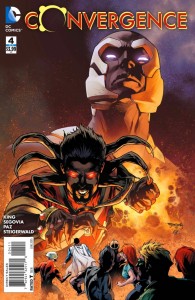 Convergence #4 (of 8) — Writer: Jeff King; Pencils: Stephen Segovia; Inks: Seven different guys; Colors: John Starr with Peter Steigerwald
Convergence #4 (of 8) — Writer: Jeff King; Pencils: Stephen Segovia; Inks: Seven different guys; Colors: John Starr with Peter Steigerwald
The main title gets a lot more linear this issue, with an actual plot that begins to tie everything together: the Earth-2 heroes, fleeing Telos, have ended up in The Warlord’s dimension of Skartaris, where the evil wizard Deimos is trying to con them into helping him take over, with partial success. At the same time, Deimos’s magic has let him figure out what’s really going on with the Convergence, so he resets his goals considerably higher, ending in a last-page reveal involving him, the Earth-2 heroes, the time-traveling characters at Vanishing Point, Telos, and another major character. This was the best issue so far from a storytelling point of view, although  Segovia’s art, while solid, tends to be a little too murky — and it isn’t helped by the tag-team inkers, which sometimes cause noticeable changes in the style.
Segovia’s art, while solid, tends to be a little too murky — and it isn’t helped by the tag-team inkers, which sometimes cause noticeable changes in the style.
Convergence: Action Comics #1 (of 2) — Writer: Justin Gray; Art: Claude St.-Aubin; Colors: Lovern Kindzierski
Convergence: Detective Comics #1 (of 2) — Writer: Len Wein; Pencils: Denys Cowan; Inks: Bill Sienkiewicz; Colors: Chris Sotomayor and Felix Serrano
Convergence: Infinity Inc. #1 (of 2) — Writer: Jerry Ordway; Art: Ben Caldwell
Convergence: Justice Society of America #1 (of 2) — Writer: Dan Abnett; Pencils: Tom Derenick; Inks: Trevor Scott; Colors: Monica Kubina
 Convergence: World’s Finest #1 (of 2) — Writer: Paul Levitz; Pencils: Jim Fern; Inks: Joe Rubinstein; Colors: Paul Mounts
Convergence: World’s Finest #1 (of 2) — Writer: Paul Levitz; Pencils: Jim Fern; Inks: Joe Rubinstein; Colors: Paul Mounts
The previous three weeks have had all ten tie-in titles following the same group of heroes (pre-Crisis Earth-1; pre-Zero Hour Earth-1, etc.) but this week changes the formula. These five books all cover the same group: the Earth-2 heroes from just before Crisis: so, the aging Golden-Age versions of Flash, Green Lantern, Superman, etc., plus second-generation heroes like Infinity Inc. They’re fighting three different cities: the apocalyptic-future Atlanta from Hex (the one where Jonah Hex was transplanted from the Wild West to a Mad Max-like landscape; no, I don’t know who thought that was a good plan, either…), the Moscow inhabited by the Superman from  Red Son, and a third city where the Silver Age Green Lantern foes, the anti-matter Weaponers of Qward, live. This allows the Chip Kidd alternate covers to draw from some great sources: in Action Comics #1, it’s a Keith Giffen/Wally Wood version of the Earth-2 Superman, for example. The story is typical for these titles: it’s mostly about the year of depowered life under the dome for the married Superman and Lois, Power Girl, etc., intercut with life in the Red Son Moscow, where that version of Superman faces similar constraints; at the end of the issue, the dome drops and everybody has to gear up and fight… next issue. OK art, and interesting if you like those characters (and it is good to these old-school versions of the Earth-2 heroes again). Detective follows the grown-up Robin and the Huntress who’s the daughter of the now-deceased Earth-2 Batman, along
Red Son, and a third city where the Silver Age Green Lantern foes, the anti-matter Weaponers of Qward, live. This allows the Chip Kidd alternate covers to draw from some great sources: in Action Comics #1, it’s a Keith Giffen/Wally Wood version of the Earth-2 Superman, for example. The story is typical for these titles: it’s mostly about the year of depowered life under the dome for the married Superman and Lois, Power Girl, etc., intercut with life in the Red Son Moscow, where that version of Superman faces similar constraints; at the end of the issue, the dome drops and everybody has to gear up and fight… next issue. OK art, and interesting if you like those characters (and it is good to these old-school versions of the Earth-2 heroes again). Detective follows the grown-up Robin and the Huntress who’s the daughter of the now-deceased Earth-2 Batman, along 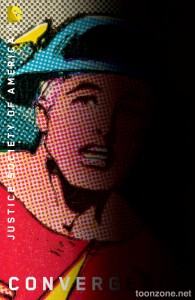 with, again, the Superman of Red Son, and has the advantage of dropping the dome only halfway through, and letting the characters actually encounter one another and fight this issue. The Wein/Cowan/Sienkiewicz team offers a clever, even-handed look at everyone, and some of the better-looking art from this week’s books. Infinity Inc. has a script by Ordway, who was the artist on many of that title’s early issues (and it’s nice to see Kidd use a Jade panel from him for the alternate cover), although it’s strange to see them fight the Jonah Hex/future mutants group. There’s also a weird misstep: one of Hex’s allies blasts the Infinity Inc. team’s ship out of the skies, and we don’t see it: we see him aiming, and then Hex tells us that it happened (“Ya blasted their ship to pieces, and took out the fancy-pants with one shot. Ahm almost impressed.”) Um, shouldn’t that have been a full-page splash,
with, again, the Superman of Red Son, and has the advantage of dropping the dome only halfway through, and letting the characters actually encounter one another and fight this issue. The Wein/Cowan/Sienkiewicz team offers a clever, even-handed look at everyone, and some of the better-looking art from this week’s books. Infinity Inc. has a script by Ordway, who was the artist on many of that title’s early issues (and it’s nice to see Kidd use a Jade panel from him for the alternate cover), although it’s strange to see them fight the Jonah Hex/future mutants group. There’s also a weird misstep: one of Hex’s allies blasts the Infinity Inc. team’s ship out of the skies, and we don’t see it: we see him aiming, and then Hex tells us that it happened (“Ya blasted their ship to pieces, and took out the fancy-pants with one shot. Ahm almost impressed.”) Um, shouldn’t that have been a full-page splash,  and shouldn’t a writer like Ordway, who’s also an artist, have known how much better it is to show than tell? Next up, Justice Society of America focuses on the now-geriatric members of that group — Jay “Flash” Garrick, Kent “Dr. Fate” Nelson, Alan “Green Lantern” Scott and Carter “Hawkman” Hall — as they have to defend their city against the Weaponers of Qward. It’s another of those “tune in next issue for the real fight” plots, but Abnett does a good job of setting things up, and offering the old guys one more burst of youthful glory. World’s Finest gets points for using the non-powered artist character Scribbly (and putting him on the cover, a tribute to the great Sheldon Mayer), plus the Seven Soldiers of Victory; writer Paul Levitz probably knows more about those characters than anyone still alive, and treats them
and shouldn’t a writer like Ordway, who’s also an artist, have known how much better it is to show than tell? Next up, Justice Society of America focuses on the now-geriatric members of that group — Jay “Flash” Garrick, Kent “Dr. Fate” Nelson, Alan “Green Lantern” Scott and Carter “Hawkman” Hall — as they have to defend their city against the Weaponers of Qward. It’s another of those “tune in next issue for the real fight” plots, but Abnett does a good job of setting things up, and offering the old guys one more burst of youthful glory. World’s Finest gets points for using the non-powered artist character Scribbly (and putting him on the cover, a tribute to the great Sheldon Mayer), plus the Seven Soldiers of Victory; writer Paul Levitz probably knows more about those characters than anyone still alive, and treats them 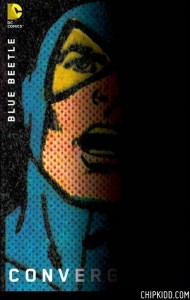 with affection and respect, although this is another title that ends just when the actual fight’s about to begin.
with affection and respect, although this is another title that ends just when the actual fight’s about to begin.
Convergence: Blue Beetle #1 (of 2) — Writer: Scott Lobdell; Art: Yishan Li; Colors: Dave McCaig
Convergence: Booster Gold #1 (of 2) — Writer: Dan Jurgens; Pencils: Alvaro Martinez; Inks: Raul Fernandez; Colors: Chris Sotomayor
Convergence: Crime Syndicate #1 (of 2) — Writer: Brian Buccellato; Art: Phil Winslade; Colors: Lovern Kindzierski
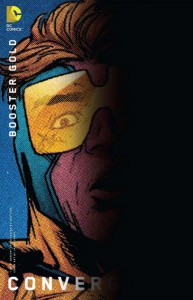 Convergence: Plastic Man and the Freedom Fighters # 1 (of 2) — Writer: Simon Oliver; Art: John McRea; Colors: John Kalisz
Convergence: Plastic Man and the Freedom Fighters # 1 (of 2) — Writer: Simon Oliver; Art: John McRea; Colors: John Kalisz
Convergence: Shazam #1 (of 2) — Writer: Jeff Parker; Art: Evan “Doc” Shaner; Colors: Jordie Bellaire
The other five Convergence tie-ins this week each focus on a different city and era: a good chance to see some obscure old friends. Blue Beetle covers Hub City (which is to say, the ’60s Charleton characters — The Question, Captain Atom and the title character, mostly). Li’s art gives everything a clean, shiny novelty, although this is another book where 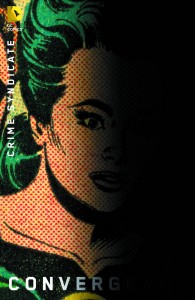 the dome doesn’t drop until the last page, and we never even see the city’s adversaries — the 31st-century Legion of Super-Heroes — until, presumably, next issue. Booster Gold is more of a companion to the main mini-series: there’s no dome, since Booster is at Vanishing Point, discovering a number of the other captured time travelers, and witnessing the events in Skartaris, too (and, unlike in Blue Beetle, he actually encounters the Legion). This feels a lot more essential to the overall story than almost all of the other tie-ins; Dan Jurgens, the writer, is the character’s creator and longtime chronicler, too, so there are a lot of decent character beats, and a last page that longtime fans will appreciate. Crime Syndicate features those Earth-3, dark-mirror versions of the regular
the dome doesn’t drop until the last page, and we never even see the city’s adversaries — the 31st-century Legion of Super-Heroes — until, presumably, next issue. Booster Gold is more of a companion to the main mini-series: there’s no dome, since Booster is at Vanishing Point, discovering a number of the other captured time travelers, and witnessing the events in Skartaris, too (and, unlike in Blue Beetle, he actually encounters the Legion). This feels a lot more essential to the overall story than almost all of the other tie-ins; Dan Jurgens, the writer, is the character’s creator and longtime chronicler, too, so there are a lot of decent character beats, and a last page that longtime fans will appreciate. Crime Syndicate features those Earth-3, dark-mirror versions of the regular 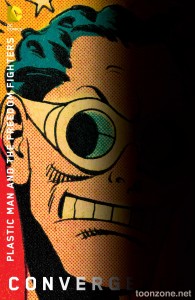 DC heroes, up against the 853rd-century Justice League from those DC: One Million issues that Grant Morrison coordinated close to two decades ago; it’s got the advantages of a number of intriguing characters and Phil Winslade’s very solidly-composed art — and it’s another book where there’s at least a little actual fighting by the end of the issue. Plastic Man and the Freedom Fighters follows that group’s Earth-X city (from a timeline where Germany won WWII, and America’s been conquered by the Nazis for a couple of decades), and pits it against the Futures End timeline, where all the heroes have been converted into techno-robotic killers. The attraction here is the John McRea art; he has a knack for gritty violence that serves him well (and should work even better next issue, when the
DC heroes, up against the 853rd-century Justice League from those DC: One Million issues that Grant Morrison coordinated close to two decades ago; it’s got the advantages of a number of intriguing characters and Phil Winslade’s very solidly-composed art — and it’s another book where there’s at least a little actual fighting by the end of the issue. Plastic Man and the Freedom Fighters follows that group’s Earth-X city (from a timeline where Germany won WWII, and America’s been conquered by the Nazis for a couple of decades), and pits it against the Futures End timeline, where all the heroes have been converted into techno-robotic killers. The attraction here is the John McRea art; he has a knack for gritty violence that serves him well (and should work even better next issue, when the 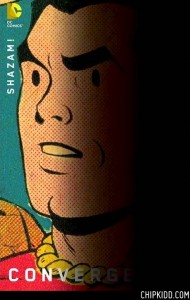 killer robots actually show up — if the last-page splash is any indication). Finally, Shazam is just what you think: the Earth-Fawcett characters, from right around the time of their ’70s revival. The Shaner art does a decent, Don Newtonish job of combining the cartoonier and the more realistic styles required here, and Parker’s script has a number of callbacks for old Fawcett fans (the city they’re fighting is the Victorian-Batman Gotham by Gaslight one, so it barely shows up here — wisely, since Parker’s going to have to stretch to make it much of a fight, with three of Earth’s mightiest mortals against a bunch of steampunk blimps). Next week: the second issues start, and we get to see the other halves of Kidd’s cover designs….
killer robots actually show up — if the last-page splash is any indication). Finally, Shazam is just what you think: the Earth-Fawcett characters, from right around the time of their ’70s revival. The Shaner art does a decent, Don Newtonish job of combining the cartoonier and the more realistic styles required here, and Parker’s script has a number of callbacks for old Fawcett fans (the city they’re fighting is the Victorian-Batman Gotham by Gaslight one, so it barely shows up here — wisely, since Parker’s going to have to stretch to make it much of a fight, with three of Earth’s mightiest mortals against a bunch of steampunk blimps). Next week: the second issues start, and we get to see the other halves of Kidd’s cover designs….
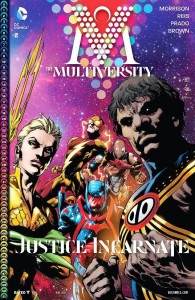 Multiversity #2 (of 2) — Writer: Grant Morrison; Pencils: Ivan Reis; Inks: Three guys; Colors: Three guys
Multiversity #2 (of 2) — Writer: Grant Morrison; Pencils: Ivan Reis; Inks: Three guys; Colors: Three guys
Justice League #40 — Writer: Geoff Johns; Art: Eight guys; Colors: Brad Anderson and Alex Sinclair
Batman #40 — Writer: Scott Snyder; Pencils: Greg Capullo; Inks: Danny Miki; Colors: FCO Plascencia
Superman #40 — Writer/Pencils: John Romita Jr.; Inks: Klaus Janson; Colors: Travis Lanham
 Vertigo Quarterly SFX #1: Pop! — Creators: Various
Vertigo Quarterly SFX #1: Pop! — Creators: Various
There are an unusual number of important DC books this week — Multiversity would be the highlight of most weeks, but is overshadowed by the Convergence juggernaut (one book to eleven). Too bad, because it’s what I wanted that series to be: a sprawling, character-stuffed, all-action throwdown between the heroes of dozens of worlds (everyone from Captain Carrot to Mary Marvel to a female Aquaman to the Barack Obama Superman to Nix Uotan, the last Monitor), and an ancient, unstoppable cosmic horror. Morrison is adept at this sort of thing, of course,  and Reis shows a George Perez-like facility for drawing hundreds of different characters and making it look easy. Justice League is yet another cosmic plot: Metron encounters the Anti-Monitor, we get a number of callbacks to Crisis on Infinite Earths, and a new character, one who could play an important role in later books, is introduced. Batman is another comic that would be getting the most press in a normal week, as it features the no-kidding conclusion of what, for now, looks like the last battle between Bruce Wayne and the Joker; Snyder and Capullo deliver their normal fan-friendly job, although the resolution here mostly made me think back to
and Reis shows a George Perez-like facility for drawing hundreds of different characters and making it look easy. Justice League is yet another cosmic plot: Metron encounters the Anti-Monitor, we get a number of callbacks to Crisis on Infinite Earths, and a new character, one who could play an important role in later books, is introduced. Batman is another comic that would be getting the most press in a normal week, as it features the no-kidding conclusion of what, for now, looks like the last battle between Bruce Wayne and the Joker; Snyder and Capullo deliver their normal fan-friendly job, although the resolution here mostly made me think back to 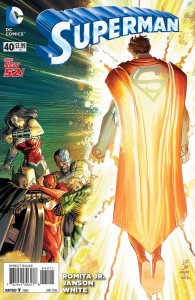 Knightfall and Batman #500, and feel old because that happened over 22 years ago (and, of course, that looked permanent and turned out to be anything but that, too — a lesson for anyone who thinks that Bruce Wayne’s fate in this comic is somehow permanent). Superman features John Romita Jr. both writing and drawing the book (with inks by Janson), building on developments from the previous issue, as Superman has a new power that leaves him drained and human for a while after he uses it. There’s a lot to like here: the Justice League acting like actual super-friends (particular Clark and Bruce), and a depowered Superman who gets all loopy after half a glass of lite beer; based on this, I’d be happy to have Romita working double-creator duty on this book for a long
Knightfall and Batman #500, and feel old because that happened over 22 years ago (and, of course, that looked permanent and turned out to be anything but that, too — a lesson for anyone who thinks that Bruce Wayne’s fate in this comic is somehow permanent). Superman features John Romita Jr. both writing and drawing the book (with inks by Janson), building on developments from the previous issue, as Superman has a new power that leaves him drained and human for a while after he uses it. There’s a lot to like here: the Justice League acting like actual super-friends (particular Clark and Bruce), and a depowered Superman who gets all loopy after half a glass of lite beer; based on this, I’d be happy to have Romita working double-creator duty on this book for a long 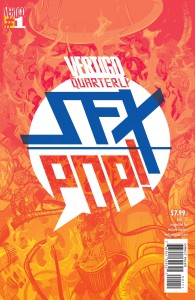 time. Vertigo Quarterly SFX is that imprint’s typical anthology of sf, horror and other short stories: nine in all, connected by a “pop” that, in the last story, is explained by Peter Milligan. Books like this stand or fall on the number of cool new artists they feature, so here’s the list for this issue: Nathan Fox, Matt Rockefeller, Sara Richard, Szymon Kudranski, David Hahn, Rosemary Valero-O’Connell, Brett Parson, Hope Larson and Celia Calle. Page through this on the stands and you very well might decide to pick it up; for $7.99, you should be attracted to at least two or three of these people, and you’ll come away knowing a lot more about today’s cutting-edge comics styles than you did before.
time. Vertigo Quarterly SFX is that imprint’s typical anthology of sf, horror and other short stories: nine in all, connected by a “pop” that, in the last story, is explained by Peter Milligan. Books like this stand or fall on the number of cool new artists they feature, so here’s the list for this issue: Nathan Fox, Matt Rockefeller, Sara Richard, Szymon Kudranski, David Hahn, Rosemary Valero-O’Connell, Brett Parson, Hope Larson and Celia Calle. Page through this on the stands and you very well might decide to pick it up; for $7.99, you should be attracted to at least two or three of these people, and you’ll come away knowing a lot more about today’s cutting-edge comics styles than you did before.
 Bitch Planet #4 — Writer: Kelly Sue DeConnick; Art: Valentine de Landro; Colors: Chris Peter
Bitch Planet #4 — Writer: Kelly Sue DeConnick; Art: Valentine de Landro; Colors: Chris Peter
Red One #2 — Writer: Xavier Dodson; Pencils/Colors: Terry Dodson; Inks: Rachel Dodson
Outcast #8 — Writer: Robert Kirkman; Art: Paul Azaceta; Colors: Elizabeth Breitweiser
The most interesting indy titles for the week — and, not surprisingly, they’re all from Image, the go-to company for creators who want to retain ownership of their work and  still get professional distribution and printing. Bitch Planet started with a big splash, and has lost a little momentum due to lateness — although DeConnick makes up for it in the editorial material, talking first about how getting a women’s-prison-planet shower sex scene right took a long time because, as two women, she and deLandro “wanted to deliver on the exploitation tropes, but we didn’t want the depiction to be male-gazey” (as good a summary of the book’s mission statement as any), and then talks about the phenomenon of real-life women getting the book’s “non-compliant” tattoo, a mark of shame for the patriarchal society in the book, but a badge of honor to them. The story itself reminds us all why we liked this book
still get professional distribution and printing. Bitch Planet started with a big splash, and has lost a little momentum due to lateness — although DeConnick makes up for it in the editorial material, talking first about how getting a women’s-prison-planet shower sex scene right took a long time because, as two women, she and deLandro “wanted to deliver on the exploitation tropes, but we didn’t want the depiction to be male-gazey” (as good a summary of the book’s mission statement as any), and then talks about the phenomenon of real-life women getting the book’s “non-compliant” tattoo, a mark of shame for the patriarchal society in the book, but a badge of honor to them. The story itself reminds us all why we liked this book 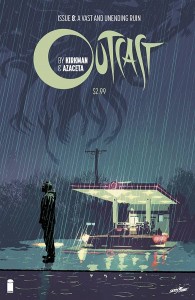 to begin with: it’s smart, stylized, action-packed, very human and very good-looking, and it’s nice to have this comic back on schedule. Red One is an interesting book to check out next, because it’s nothing if not “male-gazey,” but it’s also so charming and light-spirited, in its depiction of a Soviet spy who’s a knockout (in many senses of the word) who’s come to America to become a super-hero, that it’s easy to like. Outcast has just the opposite tone: dark and paranoid, with a hero who can exorcise possessed people, but is beginning to find that there are a lot more of them, and they have more powerful backup, than he’s realized; Azaceta nails a double-page splash at the end that’s a masterpiece of quiet, normal-looking-but-sinister dread.
to begin with: it’s smart, stylized, action-packed, very human and very good-looking, and it’s nice to have this comic back on schedule. Red One is an interesting book to check out next, because it’s nothing if not “male-gazey,” but it’s also so charming and light-spirited, in its depiction of a Soviet spy who’s a knockout (in many senses of the word) who’s come to America to become a super-hero, that it’s easy to like. Outcast has just the opposite tone: dark and paranoid, with a hero who can exorcise possessed people, but is beginning to find that there are a lot more of them, and they have more powerful backup, than he’s realized; Azaceta nails a double-page splash at the end that’s a masterpiece of quiet, normal-looking-but-sinister dread.
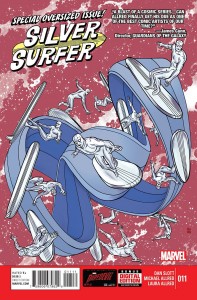 Silver Surfer #11 — Writer: Dan Slott; Art: Michael Allred; Colors: Laura Allred
Silver Surfer #11 — Writer: Dan Slott; Art: Michael Allred; Colors: Laura Allred
Secret Avengers #15 — Writer: Ales Kot; Art: Michael Walsh; Colors: Matthew Wilson
Daredevil #15 — Writer: Mark Waid; Art: Chris Samnee; Colors: Matthew Wilson
Avengers #44 — Writer: Jonathan Hickman; Art: Stefano 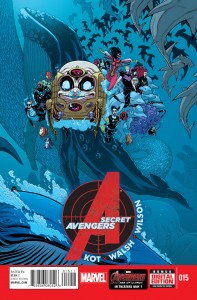 Caselli and Kev Walker; Colors: Frank Martin
Caselli and Kev Walker; Colors: Frank Martin
New Avengers 33 — Writer: Jonathan HIckman; Art: Mike Deodato; Colors: Frank Martin
The most interesting Marvel books for the week: Silver Surfer is a delight, a formal experiment in layout and design wherein the Surfer and the massive fleet of refugees with him are trapped in a cosmic Moebius strip, and the  book’s layout reflects it, requiring the reader to go around and around with them, and feel their exhilaration when the Surfer finally breaks out. Allred, as always, is the perfect artist for this kind of thing, with his precise, pop-art sensibilities able to handle the cosmic ballet and the Surfer’s small-scale, poignant relationship with the earth girl Dawn Greenwood with equal ease. Secret Avengers reaches the end of its 15-issue run with a quiet coda (the big action-packed finale was last issue), as all the characters get, if not what they
book’s layout reflects it, requiring the reader to go around and around with them, and feel their exhilaration when the Surfer finally breaks out. Allred, as always, is the perfect artist for this kind of thing, with his precise, pop-art sensibilities able to handle the cosmic ballet and the Surfer’s small-scale, poignant relationship with the earth girl Dawn Greenwood with equal ease. Secret Avengers reaches the end of its 15-issue run with a quiet coda (the big action-packed finale was last issue), as all the characters get, if not what they 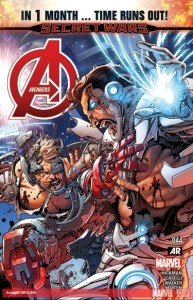 want, at least what they need, and it’s been a high-quality ride: like Young Avengers, which also went 15 issues, its combination of eye-catching, clean-looking art, compassionate and imaginative scripting, and cool colors should give it a long and well-deserved life in trade form. So too for Daredevil, which has a similar style courtesy of Waid and Samnee (and both books benefit from Matthew Wilson’s coloring); Matt Murdock may be in very big trouble now, courtesy of longtime foe The Owl, but we can trust this team to get him
want, at least what they need, and it’s been a high-quality ride: like Young Avengers, which also went 15 issues, its combination of eye-catching, clean-looking art, compassionate and imaginative scripting, and cool colors should give it a long and well-deserved life in trade form. So too for Daredevil, which has a similar style courtesy of Waid and Samnee (and both books benefit from Matthew Wilson’s coloring); Matt Murdock may be in very big trouble now, courtesy of longtime foe The Owl, but we can trust this team to get him  out of it with wit and pizzazz. Finally, there are the two Avengers books: the last of Hickman’s run, as all the plot threads of the last few years have come home. In New Avengers, Dr. Doom, Molecule Man and Dr. Strange reveal big big secrets and confront the Beyonders, while in Avengers Tony Stark and Steve Rogers have a conversation (followed by a fight) that echoes their original one way back in this volume’s first issue; both books end with a segue into Secret Wars #1, just in time for the Free Comic Book Day preview of that title and the start of the summer crossover event season — a good example of Hickman’s precise, A-level plotting and planning abilities.
out of it with wit and pizzazz. Finally, there are the two Avengers books: the last of Hickman’s run, as all the plot threads of the last few years have come home. In New Avengers, Dr. Doom, Molecule Man and Dr. Strange reveal big big secrets and confront the Beyonders, while in Avengers Tony Stark and Steve Rogers have a conversation (followed by a fight) that echoes their original one way back in this volume’s first issue; both books end with a segue into Secret Wars #1, just in time for the Free Comic Book Day preview of that title and the start of the summer crossover event season — a good example of Hickman’s precise, A-level plotting and planning abilities.



